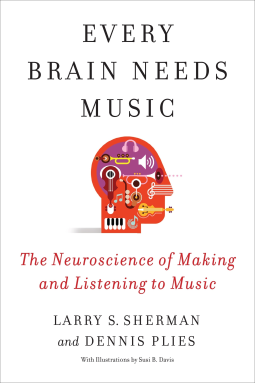Structured in eight movements (chapters), “Every Brain Needs Music” by Larry A. Sherman (a neuroscientist and musician) and Dennis Plies (a professional musician and teacher) takes the reader on a journey to better understand how human beings create, practice, perform, and listen to music.
The first movement discusses what music is and why we have it. This is a great reflection on history and putting words to a phenomenon we take for granted. The second movement looks at how the brain composes, musical and brain knowledge here would be helpful, it is a completely fascinating dig into which part of the brain does what and why. The brain is amazing! The third to fifth movements look at practicing music including the relationship between student and teacher (I have an even deeper appreciation for my piano teacher), the way the brain learns through practice (why this is my favourite part of playing – I’m a natural learner, I love the process) and how practicing changes the brain (music really is good for you!). The next three movements cover the performance of music, the listening to it, and why we like it.
Every chapter became my favourite and this is one of my favourite books! That said, I studied brain structure at varsity and played and studied piano to a grade 6 level, the vocabulary, and concepts built on a construct I already had. I’m not sure of the accessibility of the book to those who come to this world with no previous knowledge. If you have to wrestle with it, I do think you’ll be rewarded but be prepared to read with Google open to listen to the music referred to and look up unfamiliar terms. The illustrations throughout do help.
Whilst about music and neuroscience, it also teaches the reader about creativity and productive teaching methods. It shares wisdom about how to enjoy music more and keep one’s brain healthier.
It’s a five out of five on the enJOYment scale, highly recommended, and I hope I get to read these authors again.
I received a complimentary copy of the book from Columbia University Press through NetGalley. Opinions expressed in these reviews are completely my own.

From the back cover:
Whenever a person engages with music—when a piano student practices a scale, a jazz saxophonist riffs on a melody, a teenager sobs to a sad song, or a wedding guest gets down on the dance floor—countless neurons are firing. Playing an instrument requires all of the resources of the nervous system, including cognitive, sensory, and motor functions. Composition and improvisation are remarkable demonstrations of the brain’s capacity for creativity. Something as seemingly simple as listening to a tune involves mental faculties most of us don’t even realize we have.
Larry S. Sherman, a neuroscientist and lifelong musician, and Dennis Plies, a professional musician and teacher, collaborate to show how our brains and music work in harmony. They consider music in all the ways we encounter it—teaching, learning, practicing, listening, composing, improvising, and performing—in terms of neuroscience as well as music pedagogy, showing how the brain functions and even changes in the process. Every Brain Needs Music draws on leading behavioral, cellular, and molecular neuroscience research as well as surveys of more than a hundred musical people. It provides new perspectives on learning to play, teaching, how to practice and perform, the ways we react to music, and why the brain benefits from musical experiences.
Written for both musical and nonmusical people, including newcomers to brain science, this book is a lively and easy-to-read exploration of the neuroscience of music and its significance in our lives.
ABOUT THE AUTHORS
Larry S. Sherman is a professor of neuroscience at the Oregon Health and Science University. An enthusiastic piano player since age four, he has published widely on brain development, aging, and disease, and given lectures on music and the brain throughout the world.
Dennis Plies, who was for many years a music professor at Warner Pacific University, has been involved with music for his entire life. Starting at the age of seven, he played marimba for audiences and on television, and he has recorded albums in genres including gospel, classical, and jazz.
Susi B. Davis began painting watercolors in her early teens. She continues to paint in watercolors and acrylics in her studio in Portland, Oregon, where she also teaches painting. She has previously illustrated several books, including children’s books about animals and a hiking guide featuring flowers and plants in the Pacific Northwest.

